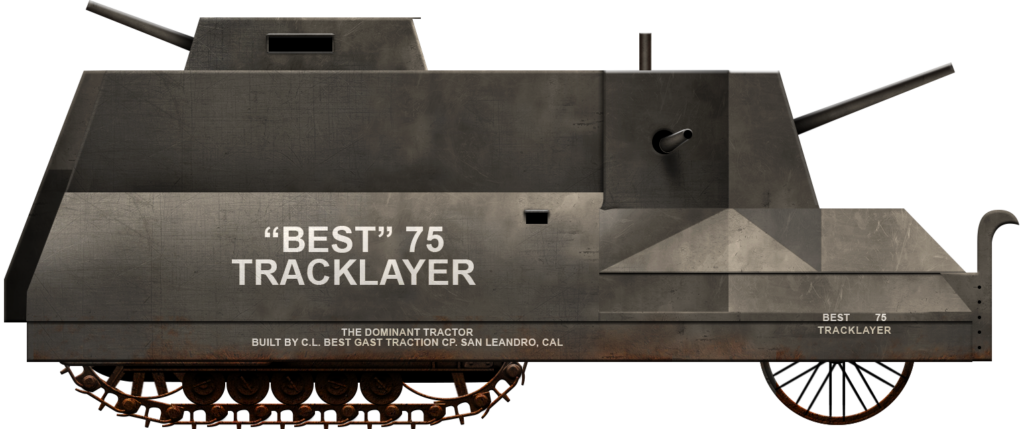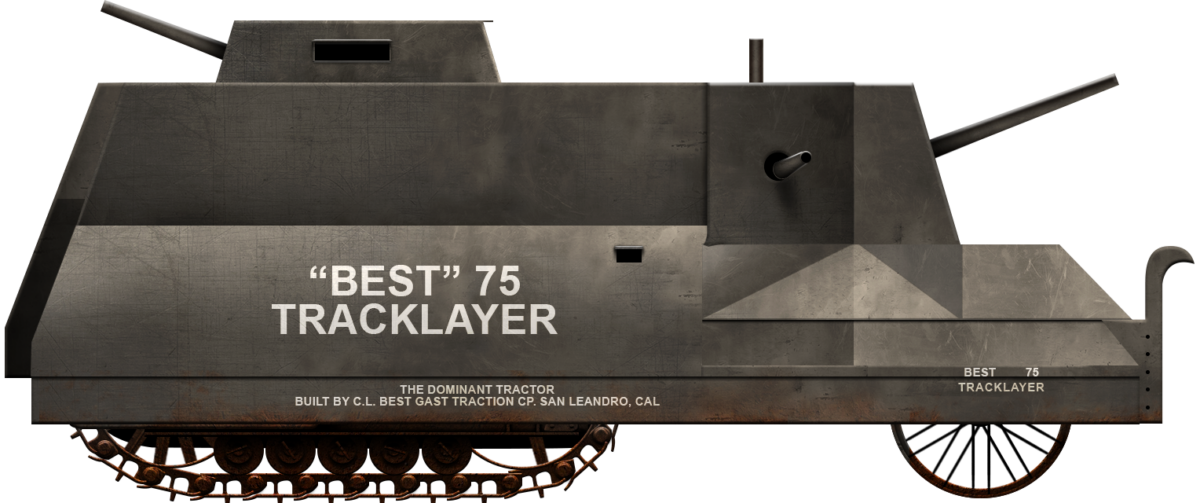 United States of America (1916)
United States of America (1916)
Mock-up Training Tank – 1 Built
In the weeks and months following the tank being unleashed on the battlefields of France by the British in September 1916, the tanks generated enormous amounts of public interest and fascination. It was not until November 1916 that photographs were available from which the public could finally understand that some of the descriptions and artistic renderings which had been circulated were wrong.
Even then, the technology of what went into the tank was secret. However, the dominant feature was not the armor or the guns, but the tracks. The USA had no tanks at the time, but it had tracked vehicle makers and, with sales of Holt tractors during the war and persistent commentary of Holt being the machines of which British tanks were based, the publicity for Holt was enormous. Holt was a maker of tractors for agricultural, commercial, and military use. A competitor of Holt was the C. L. Best company in California. They also had a heavy tractor with tracks, just like Holt, and were eager to promote themselves. A new war with armies suddenly wanting tracked vehicles was a potentially very lucrative win and, not wishing to be left out either on the credit as inspiring the British tank or for any forthcoming sales, C. L. Best produced their own ‘tank’. Based on their tractor, this vehicle was one of the first ‘tank-shaped’ objects ever made in the United States. Whilst it was not armored, it is historically important for that reason. The vehicle was not a success but it also has possibly the oldest surviving footage of a US ‘tank’ to its accomplishments as well.
The Tractor
The C. L. Best Tracklayer 75 weighed in at a whopping 28,000 pounds (14 US tons / 12.7 tonnes), making it 1,500 lbs. (680 kg) heavier than the larger and more powerful 120 hp Holt tractor and 5,000 lbs. (2,268 kg) heavier than its primary competitor, the Holt 75 (23,000 lbs / 10,432 kg). Shaped in the manner of a tricycle with a single tyreless wheel at the front for steering, a pair of track units at the back for propulsion, and an engine located near the front towards that steering wheel, the layout was common across a number of tractors of the era. It should be noted that the company founder, Clarence Leo Best, owned a patent for elements of this arrangement since 1914, but Holt also owned a series of patents and accused each other of stealing their ideas. A string of litigation and acrimonious lawsuits between them followed.
The Best tractor had started life in 1912 as the C. L. Best 70 hp. Tracklayer, but became the ‘75’ in 1913. Powered by a giant 4 cylinder (independently cast cylinders) ‘valve-in-head’ engine with a bore of 7 ¾” (197 mm) and stroke of 9” (229 mm), it produced 40 drawbar hp at 450 rpm. The Best 75 was capable of 1.5 mph (2.4 km/h) in first gear and 2.375 mph (3.8 km/h) in second gear, along with 1.625 mph (2.6 km/h) in reverse. The fluid-load was 6 Imperial gallons (27.3 liters) of petrol mixed with 66 Imperial gallons ( 300 liters) of paraffin, 7 Imperial gallons (31.8 liters) of oil, and used 27 Imperial gallons (122.7 liters) of water for cooling.
Up until 1916, these tractors were built at the company’s plant at Elmhurst, California, until manufacturing shifted to San Leandro, also in California. Production ceased in 1919 and, by the time of the merger with Holt in the early 1920s, some 734 C. L. Best Tracklayer 70 and 75 tractors had been made.

In the months following the unleashing of the tank in September 1916 and even after the first photographs of it appeared in November that year, numerous imitations were created. Some were simple wooden boxes or frames covered with canvas for use as training aids or for promotional purposes. After all, what better way could there be to promote sales for tracked vehicles than a ‘tank’? The company C. L. Best managed to put together a quick ‘tank’ using one of their tractors. It was made with a large boxy-shaped body surmounted by a large fixed conning tower at about the level of the driving station, which would indicate the men basically sat on the canopy over the tractor, within its wooden walls.

Design
The design was what might be expected from a tractor turned into a ‘tank’ at very short notice. There was no way to turn a vehicle like the Best 75 into a tank to match the images of British tanks which had been released in November 1916. With literally no other tanks from which to take design cues, the result was not much more than a giant box.
Almost childlike in its simplicity, the sides of the body tapered slightly to the roofline and curved out from about halfway up the body to go down over the tops of the tracks. The front had a pronounced step, transitioning from the tapered upper sides towards the front. In this step was a small circular loophole. The front of the vehicle was big and flat, with a large rectangular flat front angled slightly backward, with a large ‘gun’ sticking out. Around the bottom half of the vehicle, across the front, was a simple rounded front extending beyond the front steering wheel.
The roof over the engine section of the tractor was completely flat, with just the two exhausts from the engine sticking out. Behind these was a raised fixed cabin. This had a pair of large rectangular openings in the front and another on each side. In the back of the cab was a circular opening in which another ‘gun’ was located. The rear of the hull sloped down from the roof to a large bulge, the purpose of which is unknown, and thence to the back of the machine.
The location of the cabin was unfortunate, as it was directly behind the exhausts. Any smoke coming from them would not only obscure the view ahead, but also allow fumes inside, to the detriment of the occupants.

Armor and Armament
There is no documentary evidence known discussing the materials used in making the vehicle, but it is a reasonable assumption to suggest a wooden frame and either wood or sheet metal on the outside. The next vehicle from C. L. Best, which followed this one, certainly was not armored (the Tracklayer Best 75) and was made from a simple framework with sheet metal over it. Quick, cheap, light, and simple to arrange, this body would give the appearance of armor with none of the weight. The vehicle was already 14 tons in weight and any armor to cover the vehicle of these enlarged dimensions would add substantially to that.

One thing which is clear from the vehicle, however, is the ‘guns’. They were clearly not just simple wooden or metal tubes or mock-ups, but could also pretend to ‘fire’. A simple black powder charge or something similar would function as a blank to simulate it firing. This can be seen in remarkable footage from British Pathe of the vehicle during exercise in early 1917. However, despite this mock gunfire ability, the vehicle was unarmed.

Crew
No written record of how many men it took to crew the vehicle is known, but the vehicle which followed it did have a discussion of crewing. The Day Book of 25th April 1917 revealed that as well as the single driver, presumably sitting in the normal position above the tracks towards the rear on the right-hand side, a pair of ‘lookouts’ were also used. The pair of loopholes on the front of the vehicle could serve as a lookout for the driver, for whom there would be no view of the road ahead. In order to operate the ‘guns’, even during a mock battle, probably another 3 men would have been needed as well.

Use and End
The vehicle did not see much use for exercises. It was clearly a very crude rendition of a ‘tank’ for the purposes of training and disappeared around March 1917. When it reappeared, it had a different form, rounded and rather sleek, with a single fully rotating turret. The vehicle had dubious value as a training tool, being so big, so slow, and so different from real tanks. It went no further than its mock-up and survives today as only a short length of film and a few photographs.

Source: NARA Ref: 165-WW-313-B-9

Source: NARA Ref: 165-WW0313-B-8

Sources
Bache, R. (1917). Our Forts on Wheels. Modern Mechanix Magazine, June 1917.
Bache, R. (1917). Our Forts on Wheels. Illustrated World, June 1917.
British Pathe Video. ‘American Tanks in Action (1917).
Butte Daily Post 22nd May 1917. Big ‘Tank’ inspires youths with patriotism ambles down street through surprised traffic’
Crismon, F. (1992). US Military Tracked Vehicles. Crestline Publishing, USA
Haddock, K. (2001). Classic Caterpillar Crawlers. MBI Publishing, USA
LeGros. (1918). Traction on Bad Roads. Reprinted 2021 FWD Publishing, USA
The Day Book. (25th April 1917). Yankee Tank in Action Amazes.
The West Virginian, 4th June 1917. Big ‘tank’ inspires youths with patriotism.
Young, J., Buddy, J. (1989). Endless Tracks in the Woods. Crestline Publishing, USA

